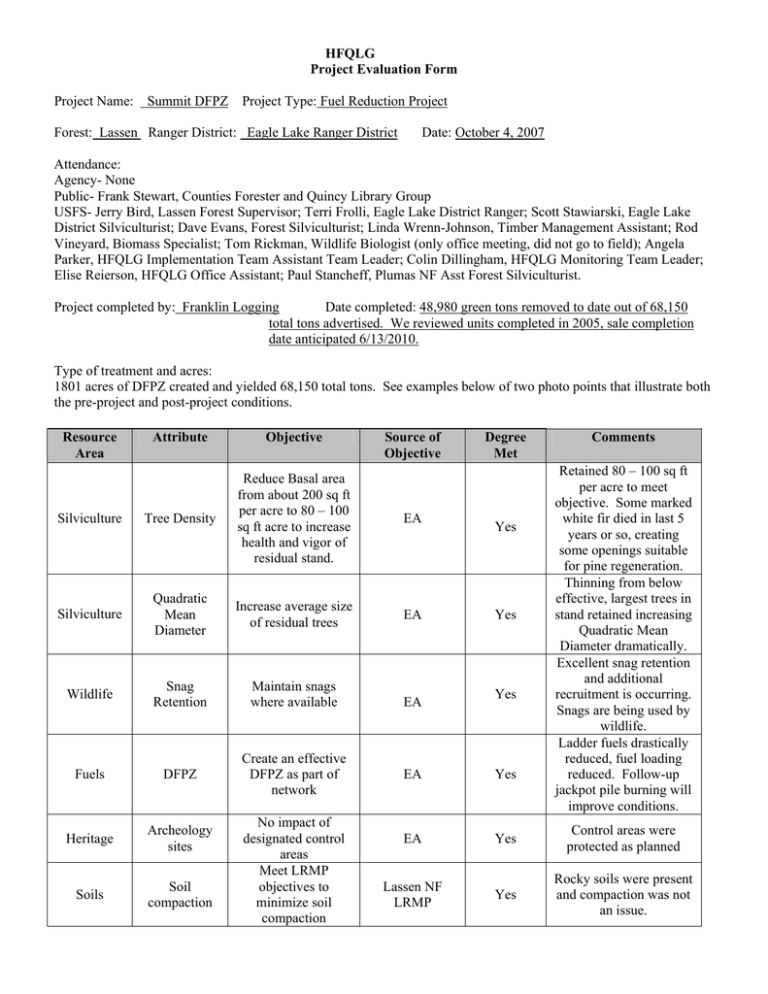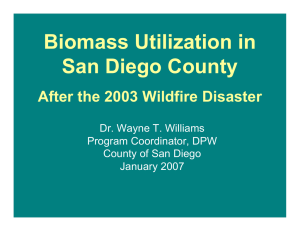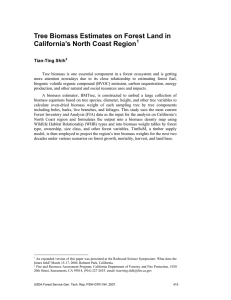HFQLG Project Evaluation Form
advertisement

HFQLG Project Evaluation Form Project Name: Summit DFPZ Project Type: Fuel Reduction Project Forest: Lassen Ranger District: Eagle Lake Ranger District Date: October 4, 2007 Attendance: Agency- None Public- Frank Stewart, Counties Forester and Quincy Library Group USFS- Jerry Bird, Lassen Forest Supervisor; Terri Frolli, Eagle Lake District Ranger; Scott Stawiarski, Eagle Lake District Silviculturist; Dave Evans, Forest Silviculturist; Linda Wrenn-Johnson, Timber Management Assistant; Rod Vineyard, Biomass Specialist; Tom Rickman, Wildlife Biologist (only office meeting, did not go to field); Angela Parker, HFQLG Implementation Team Assistant Team Leader; Colin Dillingham, HFQLG Monitoring Team Leader; Elise Reierson, HFQLG Office Assistant; Paul Stancheff, Plumas NF Asst Forest Silviculturist. Project completed by: Franklin Logging Date completed: 48,980 green tons removed to date out of 68,150 total tons advertised. We reviewed units completed in 2005, sale completion date anticipated 6/13/2010. Type of treatment and acres: 1801 acres of DFPZ created and yielded 68,150 total tons. See examples below of two photo points that illustrate both the pre-project and post-project conditions. Resource Area Attribute Objective Silviculture Tree Density Reduce Basal area from about 200 sq ft per acre to 80 – 100 sq ft acre to increase health and vigor of residual stand. EA Silviculture Quadratic Mean Diameter Increase average size of residual trees EA Wildlife Snag Retention Maintain snags where available Fuels DFPZ Create an effective DFPZ as part of network Heritage Archeology sites Soils Soil compaction No impact of designated control areas Meet LRMP objectives to minimize soil compaction Source of Objective EA Degree Met Yes Yes Yes Comments Retained 80 – 100 sq ft per acre to meet objective. Some marked white fir died in last 5 years or so, creating some openings suitable for pine regeneration. Thinning from below effective, largest trees in stand retained increasing Quadratic Mean Diameter dramatically. Excellent snag retention and additional recruitment is occurring. Snags are being used by wildlife. Ladder fuels drastically reduced, fuel loading reduced. Follow-up jackpot pile burning will improve conditions. EA Yes EA Yes Control areas were protected as planned Lassen NF LRMP Yes Rocky soils were present and compaction was not an issue. Summit DFPZ Small Log Timber Sale (HFQLG) Mixed Conifer prior to harvesting (2005) Mixed Conifer after harvesting (2006) .Removed to date 36.8 tons/ac., which was 52% sawlogs and 48% biomass chips. .Generated $417,799.40 or $314.14/ac. in revenues for the portion of the sale which is harvested. .The objectives were to develop a DPFZ and improve stand health and vigor. Lassen National Forest .CASPO Prescription Eagle Lake Ranger District Susanville, Ca Akcpc/C:/akcworkspace2007/rodshandouts/photopoints/plot6 Summit DFPZ Small Log Timber Sale (HFQLG) Mixed Conifer prior to harvesting (2005) Mixed Conifer after harvesting (2006) .Removed to date 36.8 tons/ac., which was 52% sawlogs and 48% biomass chips. .Generated $417,799.40 or $314.14/ac. in revenues for the portion of the sale which is harvested. .The objectives were to develop a DPFZ and improve stand health and vigor. Lassen National Forest .CASPO Prescription Eagle Lake Ranger District Susanville, Ca Akcpc/C:/akcworkspace2007/rodshandouts/photopoints/plot4 Shortcomings and Successes: Highly successful DFPZ implementation with excellent economic return to federal treasury in an area without high value resources. The purchaser (Franklin Logging) has a small log mill and was able to get added value material (7 – 9.9” diameter logs) made into boards rather than biomass. Although the advertised volume had 13,404 green tons of sawtimber and 54,746 tons of biomass (20% sawtimber) the purchaser was able, through utilizing small material, to harvest the material as 52% sawlogs and 48% biomass chips. The sealed bid resulted in a relatively high bid and brought a $581,319.50 sale value. Whole tree biomass of trees 3 – 9.9 inches resulted in removing most of the ladder fuels present. This material was removed from the site in the form of biomass and small logs. The canopy has been drastically reduced, resulting in a DFPZ that would bring a canopy fire to the ground and has created an area that would be safe for firefighters to fight wildfire. Aerial retardant could be effectively applied in this DFPZ. The forest conditions were poor prior to stand entry, with a large amount of dead, dying and downed trees. The fuel loading on the ground is high, too high to prevent mortality in the stand during wildfire or prescribed fire burning. The follow-up work noted below is on schedule for completion. Stand conditions similar to this are good candidates for Group Selection treatments. This project was planned prior to group selection goals, but future group selections in this forest type were recognized to provide good ecological benefits, particularly regeneration sites for pine. Follow up actions: Jackpot pile burning is needed and planned to reduce high fuel loading. This is scheduled to be accomplished with KV funding. After jackpot burning is accomplished, additional underburning may be recommended to make this stand able to survive a fire. District Ranger: __/s/ Theresa M. Frolli__________________________ Date: 10/17/07____



